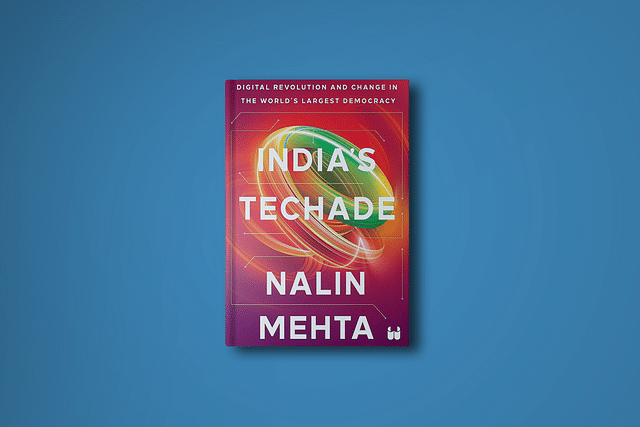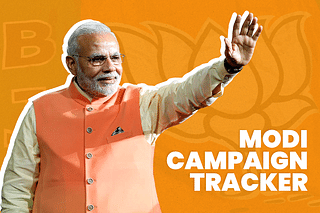Tech
India's Techade: An Early Draft Of The Indian Digital State's History
Aravindan Neelakandan
Sep 29, 2023, 05:15 PM | Updated 05:15 PM IST
Save & read from anywhere!
Bookmark stories for easy access on any device or the Swarajya app.

India’s Techade: Digital Revolution and Change in the World’s Largest Democracy. Nalin Mehta. Westland. Pages 184. Rs 420.
It's a viral video. Former Finance Minister P. Chidambaram, addressing the Indian Parliament, and dismissing the concept of digital payments in India.
"Does a humble vegetable vendor carry a POS machine? Is there a stable electricity source? And what about Wi-Fi? Should vendors in village fairs wield POS machines?"
Just the day before I wrote this review, I visited a fair in my hometown, a remote location in the southernmost part of India, Kanyakumari district. Nearly every vendor had a means of accepting digital payments. The rhetorical brilliance of the former Minister's question, "Can a vegetable vendor accept 7 rupees fifty paise through digital means?" sounded compelling back then. Today, the question appears absurd.
The book in my hands, Nalin Mehta’s India’s Techade (Westland, 2023), encapsulates this revolution. The book, through empirical precision but a lucid narrative shows how the government integrated cutting-edge digital technologies into the daily lives of Indians. This revolution, though nearly unparalleled, often remains underreported and is frequently taken for granted.
The book starts with the author meeting Prime Minister Modi and asking him about Aadhaar scheme which the latter opposed as the Chief Minister of Gujarat. The PM explains that his opposition was not to the scheme but specific ground-level concerns that needed addressing before implementation.Modi also suggests that the author meet Nandan Nilekani, the chief architect of Aadhaar, who had incidentally contested the 2014 elections against the BJP.
What follows is a vision that transcends political boundaries, driving India through an exceptionally humanistic tech transformation.
Consider one of the tech metrics presented in the book: by 2019, India boasted the world’s second-highest smartphone penetration and the highest average data usage per smartphone, reaching 9.8 gigabytes (GB) per month. In 2023, the per-capita data usage has surged to 19.5 GB per month. To put this in perspective, it's equivalent to downloading about 6,600 songs.
The astute connection of these elements with Direct Beneficiary Transfer (DBT) and the creation of Jan Dhan accounts established the synergic ‘JAM Trinity’ of Jan Dhan-Aadhaar-Mobile. This term, coined in the Modi Government’s inaugural economic survey, has significantly reduced intermediaries, facilitated fraud detection, and thus, prevented system leakages.
Also important is the late Arun Jaitley’s contribution who highlighted leakages under the then prevailing schemes and showed how JAM could lead to better targeting.
The author adeptly unravels the intricate socio-cultural symbolism woven into this digital transformation. He keenly observes that naming India’s state-run ‘BHIM’ (Bharat Interface for Money) app, designed for seamless digital financial transactions via UPI, after the architect of the Constitution and champion of Dalit rights, Dr. Bhimrao Ambedkar, was no coincidence.
Dr Ambedkar's academic pursuits at Columbia University in 1915 culminated in a PhD thesis on ‘Ancient Indian Commerce’. Furthermore, his second MA thesis at the London School of Economics in 1921 bore the title ‘The Problem of the Rupee: Its Origin and its Solution.’
In his 2023 bestseller, Coming Wave, author Mustafa Suleyman, also an AI researcher and entrepreneur, asserts that the current leadership of Bharat, through its Atmanirbhar Bharat (Self-Reliant India) program, is diligently working to ensure that the world’s most populous country attains ownership of core technology systems competitive with the United States and China. He points out that India has emerged as the fourth pillar of the new global order, and with the current Indian Government’s determination to make Indian tech a reality, he boldly declares, ‘Prepare for an Indian wave.’
Nalin Mehta illuminates a crucial and vital part of how this Indian wave itself has been generated in this decade.
Save & read from anywhere!
Bookmark stories for easy access on any device or the Swarajya app.
Support Swarajya's 50 Ground Reports Project & Sponsor A Story
Every general election Swarajya does a 50 ground reports project.
Aimed only at serious readers and those who appreciate the nuances of political undercurrents, the project provides a sense of India's electoral landscape. As you know, these reports are produced after considerable investment of travel, time and effort on the ground.
This time too we've kicked off the project in style and have covered over 30 constituencies already. If you're someone who appreciates such work and have enjoyed our coverage please consider sponsoring a ground report for just Rs 2999 to Rs 19,999 - it goes a long way in helping us produce more quality reportage.
You can also back this project by becoming a subscriber for as little as Rs 999 - so do click on this links and choose a plan that suits you and back us.
Click below to contribute.





